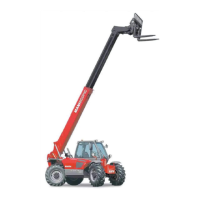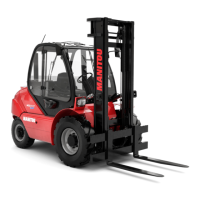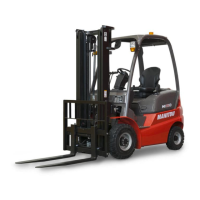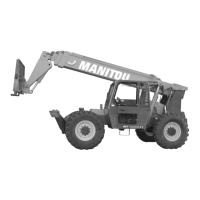ROUGH TERRAIN FORKLIFT ROUGH TERRAIN FORKLIFT TRUCK GENERAL SAFETY STANDARDS (cont.)TRUCK GENERAL SAFETY STANDARDS (cont.)
B.) GENERAL SAFETY PRACTICES (cont.)B.) GENERAL SAFETY PRACTICES (cont.)
7.) Where steering can be accomplished with either hand and the steering mechanism is of a type that pre-7.) Where steering can be accomplished with either hand and the steering mechanism is of a type that pre-
vents road reactions from causing the handwheel to spin (power steering or equivalent), steering knobs mayvents road reactions from causing the handwheel to spin (power steering or equivalent), steering knobs may
be used. be used. When used, steering knobs shall be of a type When used, steering knobs shall be of a type that can be engaged by the operator’s hand from thethat can be engaged by the operator’s hand from the
top and shall be within the periphery of the steering handwheel.top and shall be within the periphery of the steering handwheel.
8.) Experience has shown that rough terrain forklift trucks which comply with stability requirements are stable8.) Experience has shown that rough terrain forklift trucks which comply with stability requirements are stable
when properly operated. when properly operated. However, imHowever, improper operation, faulty maintenance, or poor housekeeping mproper operation, faulty maintenance, or poor housekeeping may con-ay con-
tribute to a condition of instability and defeat the purpose of the requirements.tribute to a condition of instability and defeat the purpose of the requirements.
9.) Users shall give consideration to 9.) Users shall give consideration to special operating conditions. special operating conditions. The amount of forward and rearward tilThe amount of forward and rearward tilt tot to
be used is governed by the application. be used is governed by the application. Although the use of maximum rearward tilt is allowable under certainAlthough the use of maximum rearward tilt is allowable under certain
conditions, such as traveling with the load lowered, the stability of a rough terrain forklift truck as determinedconditions, such as traveling with the load lowered, the stability of a rough terrain forklift truck as determined
by standardized tests does not encompass consideration for excessive tilt at high elevations or the operationby standardized tests does not encompass consideration for excessive tilt at high elevations or the operation
of trucks with excessive off-center loads.of trucks with excessive off-center loads.
10.) Some of the conditions which may affect stability are ground and floor conditions, grade, speed, loading10.) Some of the conditions which may affect stability are ground and floor conditions, grade, speed, loading
(rough terrain forklift trucks equipped with attachments behave as partially loaded trucks even when operated(rough terrain forklift trucks equipped with attachments behave as partially loaded trucks even when operated
without a load on the attachment), dynamic and static forces, improper tire inflation, and the judgement exer-without a load on the attachment), dynamic and static forces, improper tire inflation, and the judgement exer-
cised by the operator.cised by the operator.
C.) OPERATING SAFETY RULES AND C.) OPERATING SAFETY RULES AND PRACTICESPRACTICES
1.) Safe operation is the responsibility of the operator.1.) Safe operation is the responsibility of the operator.
2.) This equipment can be dangerous if not used properly2.) This equipment can be dangerous if not used properly. . The operator shall develop safe working habits andThe operator shall develop safe working habits and
also be aware of hazardous conditions in order to protect himself, other personnel, the rough terrain forkliftalso be aware of hazardous conditions in order to protect himself, other personnel, the rough terrain forklift
truck, and other material.truck, and other material.
3.) The operator shall be familiar with the operation and function of all controls and instruments before under-3.) The operator shall be familiar with the operation and function of all controls and instruments before under-
taking to operate the rough terrain forklift truck.taking to operate the rough terrain forklift truck.
4.) Before operating any rough terrain forklift truck, truck operators shall have read and be familiar with the4.) Before operating any rough terrain forklift truck, truck operators shall have read and be familiar with the
operator’s manual for the particular truck being operated.operator’s manual for the particular truck being operated.
5.) Before starting to operate the rough terrain forklift truck:5.) Before starting to operate the rough terrain forklift truck:
a.) be in operating position and fasten seat belt;a.) be in operating position and fasten seat belt;
b.) place directional controls in neutral;b.) place directional controls in neutral;
c.) apply brakes;c.) apply brakes;
d.) start engine.d.) start engine.
6.) Do not start or operate the rough terrain forklift truck, any of its functions, or attachments from any place6.) Do not start or operate the rough terrain forklift truck, any of its functions, or attachments from any place
other than the designated operator’s position.other than the designated operator’s position.
7.) Keep hands and feet inside the operator’s designated area or 7.) Keep hands and feet inside the operator’s designated area or compartment. compartment. Do not put any part of theDo not put any part of the
body outside the operator compartment of the rough terrain forklift truck.body outside the operator compartment of the rough terrain forklift truck.
8.) Never put any part of the body into the mast structure or between the mast and the rough terrain forklift8.) Never put any part of the body into the mast structure or between the mast and the rough terrain forklift
truck.truck.
9.) Never put any part of the body within the reach mechanism of the rough terrain forklift truck or other attach-9.) Never put any part of the body within the reach mechanism of the rough terrain forklift truck or other attach-
ments.ments.
10.) Understand rough terrain forklift limitations and operate the truck in a safe manner so as not to cause injur10.) Understand rough terrain forklift limitations and operate the truck in a safe manner so as not to cause injuryy
to personnel.to personnel.
11.) Do not allow anyone to stand or pass under the elevated portion of any rough terrain forklift truck, whether11.) Do not allow anyone to stand or pass under the elevated portion of any rough terrain forklift truck, whether
empty or loaded.empty or loaded.
12.) Do not permit passengers to ride on rough terrain forklift trucks.12.) Do not permit passengers to ride on rough terrain forklift trucks.
13.) Check clearance carefully before driving under electrical lines, bridges, etc.13.) Check clearance carefully before driving under electrical lines, bridges, etc.
14.) A rough terrain forklift truck is attended when the operator is less than 25 ft (7.6m) from the truck, which14.) A rough terrain forklift truck is attended when the operator is less than 25 ft (7.6m) from the truck, which
remains in his view.remains in his view.
15.) A rough terrain forklift truck is unattended when the operator is 25ft (7.6m) or more from the truck, which15.) A rough terrain forklift truck is unattended when the operator is 25ft (7.6m) or more from the truck, which
remains in his view, or whenever the operator leaves the truck and it is not in his view.remains in his view, or whenever the operator leaves the truck and it is not in his view.
16.) Before leaving the operator’s position:16.) Before leaving the operator’s position:
a.) bring rough terrain forklift truck to a complete stop;a.) bring rough terrain forklift truck to a complete stop;
b.) place directional controls in neutral;b.) place directional controls in neutral;
c.) apply the parking brake;c.) apply the parking brake;
d.) lower load-engaging means fully, unless supporting an occupied elevated platform;d.) lower load-engaging means fully, unless supporting an occupied elevated platform;
e.) stop the engine;e.) stop the engine;
f.) if the rough terrain forklift truck must be left on an incline, block the wheels;f.) if the rough terrain forklift truck must be left on an incline, block the wheels;
g.) fully lower the load-engaging means.g.) fully lower the load-engaging means.
17.) Maintain a safe distance from the edge of ramps, platforms, and other similar working surfaces.17.) Maintain a safe distance from the edge of ramps, platforms, and other similar working surfaces.
18.) Do no move railroad cars or trailer with a rough terrain forklift truck.18.) Do no move railroad cars or trailer with a rough terrain forklift truck.
IIIIII
CONTENTSCONTENTS
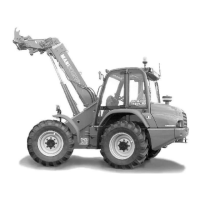
